Measuring productivity in a call center isn’t as simple as tracking how many calls an agent takes. True productivity is a delicate balance between speed, effectiveness, and customer satisfaction.
That’s where the right metrics come in.
With so many data points available—call durations, wait times, QA scores—it’s easy to get overwhelmed. Worse, focusing on the wrong metrics can lead to a decline in service quality, agent burnout, and lower customer satisfaction. To build a truly productive team, leaders need to track the right metrics—and use them not just to measure performance, but to coach, empower, and improve.
In this blog, we’ll explore the top 10 call center productivity metrics every organization should track. We’ll break down what each one means, why it matters, how to measure it effectively, and how it connects to SQM Group’s data-driven approach to improving both agent performance and customer experience.
Why do Productivity Metrics Matter?
Call center productivity metrics are more than numbers—they’re the foundation for informed decision-making, operational efficiency, and continuous improvement. When used thoughtfully, these metrics help leaders understand how well agents are managing their time, how effectively issues are being resolved, and how satisfied customers are with their experience.
But here’s the catch: not all productivity metrics are created equal.
Tracking metrics like average handle time or schedule adherence without context can do more harm than good. For example, pushing for shorter call times might seem efficient, but it can lead to rushed conversations, poor resolution, and lower customer satisfaction. That’s why the most effective call centers look at productivity through a holistic lens—one that values quality as much as quantity.
At SQM Group, we’ve spent over 25 years helping contact centers use key productivity metrics—like First Call Resolution (FCR), QA scores, and CSAT - to drive real performance improvements. The secret? Combining data with coaching. When metrics are tied to meaningful coaching and agent development, they become tools for growth, not just measurement.
The Top 10 Call Center Productivity Metrics
1. First Call Resolution (FCR)
- What it is: FCR measures the percentage of customer issues resolved on the first call, with no follow-up needed.
- Why it matters: FCR is the gold standard of productivity and customer experience. It’s not just about speed—it’s about solving the problem right the first time. Higher FCR is directly linked to increased customer satisfaction, loyalty, and lower operating costs.
- How to measure it: Use post-call surveys or internal tracking to determine if the customer’s issue was fully resolved during their first contact.
SQM research shows that, on average, every 1% improvement in FCR results in a 1% improvement in customer satisfaction. SQM’s benchmarking and customer survey tools help clients achieve world-class FCR performance.
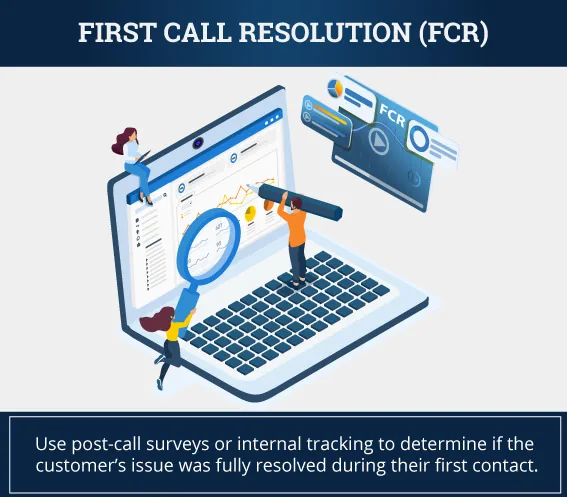
2. Average Handle Time (AHT)
- What it is: AHT includes talk time, hold time, and after-call work. It reflects the total time spent on a single customer interaction.
- Why it matters: AHT gives insight into efficiency—but shouldn’t be used in isolation. A short AHT might mean unresolved issues, while long times could signal complex calls or inefficiencies.
- How to measure it: (Talk Time + Hold Time + After Call Work) ÷ Total Calls Handled.
SQM’s research shows that Average Handle Time (AHT) is most valuable when used to identify training needs or process inefficiencies—not as a tool to pressure agents. For meaningful insights, AHT should always be analyzed alongside FCR and QA scores to provide a complete view of performance.
3. Agent Utilization Rate
- What it is: The percentage of logged-in time agents spend actively working (handling calls or completing After Call Work).
- Why it matters: This metric helps determine how effectively an agent’s time is being used.
- How to measure it: (Talk Time + After Call Work Time) ÷ Total Logged-in Time.
A high agent utilization rate is only effective when it’s sustainable over time. When combined with thoughtful coaching and regular wellness check-ins, this metric becomes a valuable tool for making informed, balanced staffing decisions that support both performance and employee well-being.
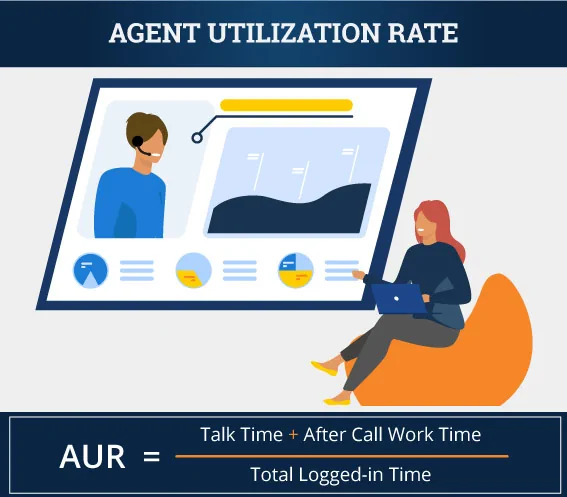
4. Occupancy Rate
- What it is: The amount of time agents spend on call-related tasks compared to their available time.
- Why it matters: It ensures you’re not over- or under-utilizing agents. Too low = inefficiency; too high = burnout risk.
- How to measure it: (Talk Time + Hold Time + After Call Work) ÷ (Total Available Time).
The optimal range for occupancy rate is often 75–85%. SQM advises monitoring occupancy rate alongside agent satisfaction to prevent attrition.
5. Service Level Agreement (SLA)
- What it is: The percentage of calls answered within a set timeframe (e.g., 80% of calls answered within 20 seconds).
- Why it matters: A high SLA means customers aren’t waiting long—and agents aren’t overwhelmed with queues.
- How to measure it: Use your call center’s ACD (Automatic Call Distributor) system to track how many calls are answered within your target time, such as answering 80% of calls within 20 seconds.
Meeting SLA should never come at the expense of call quality. A strong SLA supports, but doesn’t define, excellent customer service.
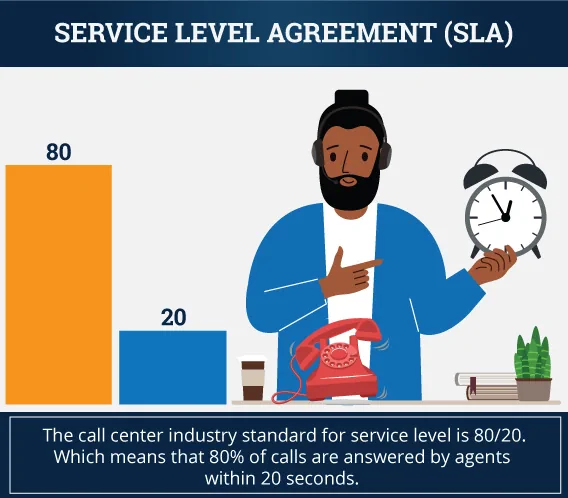
6. Schedule Adherence
- What it is: The percentage of time an agent is logged in and available compared to their scheduled hours.
- Why it matters: Helps workforce managers ensure enough coverage during high-volume periods.
- How to measure it: (Time Adhering to Schedule ÷ Total Scheduled Time) × 100.
Use adherence as a coaching opportunity, not a disciplinary metric. It’s often influenced by systems, not just agent behavior.
7. After-Call Work (ACW) Time
- What it is: Time agents spend updating records or completing follow-up tasks after a call ends.
- Why it matters: High ACW may suggest unclear processes or tools that slow agents down.
- How to measure it: Average time spent in ACW per call.
Support agents in streamlining After-Call Work (ACW) by providing effective tools, clear templates, and targeted training—ensuring efficiency without sacrificing accuracy or completeness.
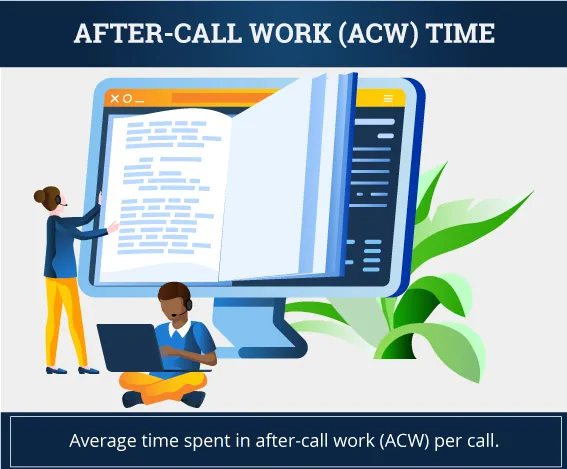
8. Transfer Rate
- What it is: The percentage of calls transferred to another department or agent.
- Why it matters: High transfer rates frustrate customers and reflect weak first-contact resolution.
- How to measure it: (# of Calls Transferred ÷ Total Calls Handled) × 100.
QA evaluations can be used to pinpoint knowledge gaps and update training or routing protocols to reduce unnecessary transfers.
9. Customer Satisfaction (CSAT) Score
- What it is: A post-call survey rating reflecting how satisfied the customer was with their interaction.
- Why it matters: CSAT is a direct line to the customer’s perception of productivity, empathy, and problem-solving.
- How to measure it: “How satisfied were you with your call today?” typically on a 1–5 or 1–10 scale.
SQM’s post-call surveys capture voice-of-the-customer feedback, helping centers link satisfaction to performance improvements.
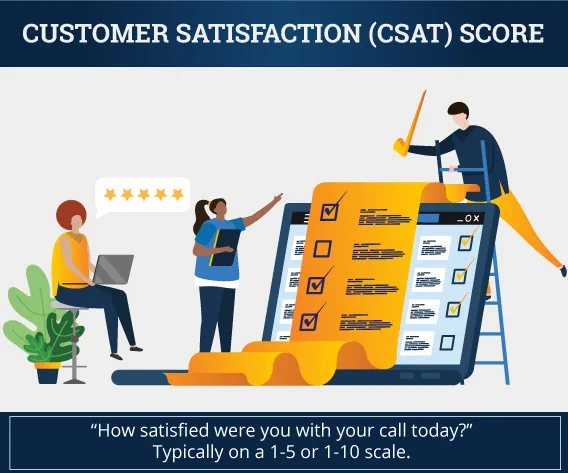
10. Quality Assurance (QA) Score
- What it is: Internal evaluation of call quality based on a predefined rubric (e.g., greeting, empathy, accuracy, compliance).
- Why it matters: QA shows how well agents are following procedures and delivering a consistent experience.
- How to measure it: Regularly review and score calls using a standardized QA checklist.
QA scores are most impactful when used for targeted coaching and paired with customer feedback. SQM’s QA best practices help clients improve both agent and customer outcomes.
How Can We Use These Metrics to Drive Improvement?
Tracking productivity metrics is only the first step. The real value comes from how you use them.
The best-performing call centers don’t just monitor numbers—they analyze trends, identify root causes, and provide feedback that empowers agents to grow. Metrics should lead to meaningful coaching conversations, not micromanagement.
For example, if an agent has a high AHT but also a strong FCR and CSAT, the issue may not be their performance—but rather the complexity of the calls they’re handling.
It’s also critical to strike the right balance. Focusing too heavily on speed-based metrics like AHT or occupancy can demoralize agents and harm the customer experience. Instead, productivity metrics should work in tandem with quality measures like QA scores and customer feedback.
At SQM Group, we believe that coaching is where metrics become transformation. Our clients use real-time dashboards, post-call surveys, and quality reviews to guide targeted coaching sessions that boost both efficiency and satisfaction. When metrics are aligned with coaching, they become a roadmap—not a scoreboard—for building high-performing, customer-focused teams.
What are Some Common Pitfalls to Avoid?
Tracking productivity metrics can significantly improve performance—but only when they’re used wisely. Without the right strategy, even well-intentioned metrics can backfire.
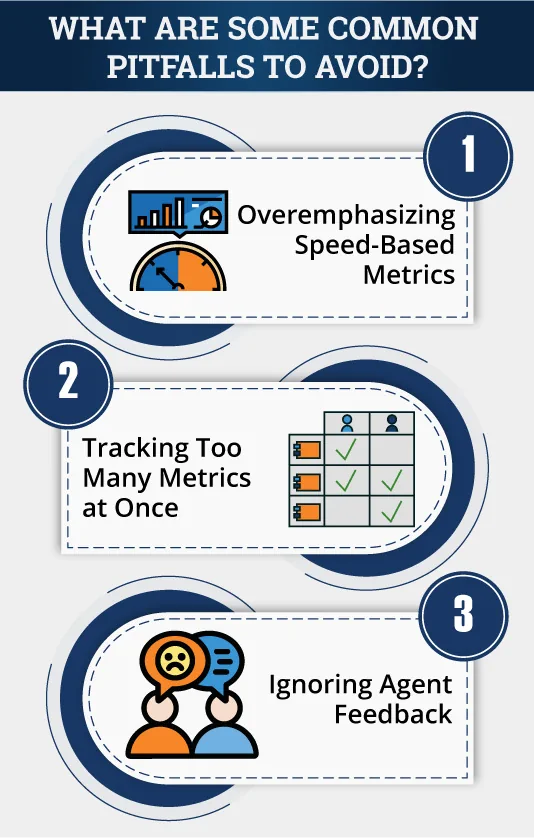
Here are some of the most common mistakes call centers make when working with productivity data—and how to avoid them:
1. Overemphasizing Speed-Based Metrics
Metrics like AHT and Occupancy Rate are useful, but if they're prioritized above all else, they can create a culture where agents feel rushed and undervalued. This often leads to decreased FCR and CSAT. Instead, use speed metrics in context—with equal attention to quality and resolution.
2. Tracking Too Many Metrics at Once
Trying to measure everything can overwhelm both leaders and agents. When agents are juggling 10+ performance targets, it’s hard to know what really matters. Focus on a core set of high-impact metrics—like FCR, CSAT, and QA scores—and use others to support specific coaching or operational goals.
3. Ignoring Agent Feedback
Agents are on the front lines and often know what’s working—and what isn’t. Failing to gather and act on their input can lead to missed opportunities for process improvement. Involve agents in metric reviews and coaching discussions to build trust and drive buy-in.
